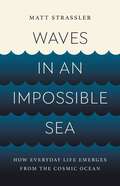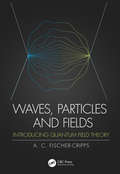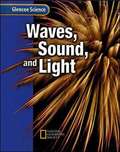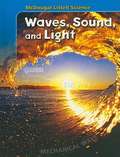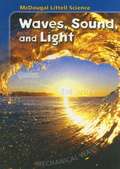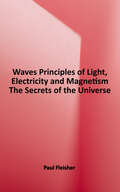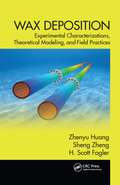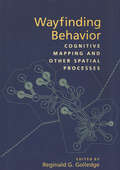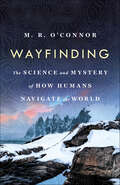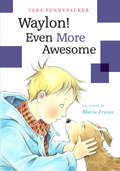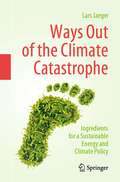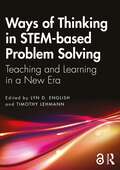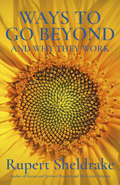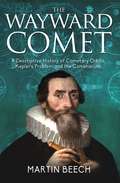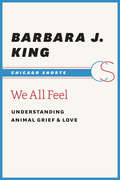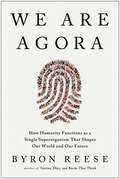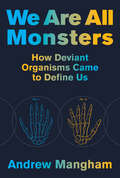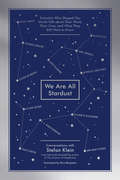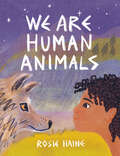- Table View
- List View
Waves in Oceanic and Coastal Waters
by Leo H. HolthuijsenWaves in Oceanic and Coastal Waters describes the observation, analysis and prediction of wind-generated waves in the open ocean, in shelf seas, and in coastal regions with islands, channels, tidal flats and inlets, estuaries, fjords and lagoons. Most of this richly illustrated book is devoted to the physical aspects of waves. After introducing observation techniques for waves, both at sea and from space, the book defines the parameters that characterise waves. Using basic statistical and physical concepts, the author discusses the prediction of waves in oceanic and coastal waters, first in terms of generalised observations, and then in terms of the more theoretical framework of the spectral energy balance. He gives the results of established theories and also the direction in which research is developing. The book ends with a description of SWAN (Simulating Waves Nearshore), the preferred computer model of the engineering community for predicting waves in coastal waters.
Waves in an Impossible Sea: How Everyday Life Emerges from the Cosmic Ocean
by Matt StrasslerA theoretical physicist takes readers on an awe-inspiring journey—found in "no other book" (Science)—to discover how the universe generates everything from nothing at all: "If you want to know what's really going on in the realms of relativity and particle physics, read this book" (Sean Carroll, author of The Biggest Ideas in the Universe). In Waves in an Impossible Sea, physicist Matt Strassler tells a startling tale of elementary particles, human experience, and empty space. He begins with a simple mystery of motion. When we drive at highway speeds with the windows down, the wind beats against our faces. Yet our planet hurtles through the cosmos at 150 miles per second, and we feel nothing of it. How can our voyage be so tranquil when, as Einstein discovered, matter warps space, and space deflects matter? The answer, Strassler reveals, is that empty space is a sea, albeit a paradoxically strange one. Much like water and air, it ripples in various ways, and we ourselves, made from its ripples, can move through space as effortlessly as waves crossing an ocean. Deftly weaving together daily experience and fundamental physics—the musical universe, the enigmatic quantum, cosmic fields, and the Higgs boson—Strassler shows us how all things, familiar and unfamiliar, emerge from what seems like nothing at all. Accessible and profound, Waves in an Impossible Sea is the ultimate guide to our place in the universe.
Waves, Energy and Information: Investigating How Dolphins Communicate, Investigation Notebook
by The Lawrence Hall of ScienceNIMAC-sourced textbook
Waves, Particles and Fields: Introducing Quantum Field Theory
by Anthony C. Fischer-CrippsChoice Outstanding Title, September 2020This book fills a gap in the middle ground between quantum mechanics of a single electron to the concept of a quantum field. In doing so, the book is divided into two parts; the first provides the necessary background to quantum theory extending from Planck’s formulation of black body radiation to Schrodinger’s equation; and the second part explores Dirac’s relativistic electron to quantum fields, finishing with an description of Feynman diagrams and their meaning. Much more than a popular account, yet not too heavy so as to be inaccessible, this book assumes no prior knowledge of quantum physics or field theory and provides the necessary foundations for readers to then progress to more advanced texts on quantum field theory. It will be of interest to undergraduate students in physics and mathematics, in addition to an interested, general audience.Features: Provides an extensive yet accessible background to the concepts Contains numerous, illustrative diagrams Presents in-depth explanations of difficult subjects
Waves, Sound, and Light
by Glencoe Mcgraw-HillDiscover the Flexibility to Teach Science Your Way!. "Glencoe Science: Waves, Sound, and Light," a module in the Glencoe Science 15 book series, provides students with accurate and comprehensive coverage of middle school National Science Education Standards. Concepts are explained in a clear, concise manner, and are integrated with a wide range of hands-on experiences, critical thinking opportunities, real-world applications, and connections to other sciences and to non-science areas of the curriculum. Co-authored by National Geographic, unparalleled graphics reinforce key concepts. A broad array of print and technology resources help differentiate and accommodate all learners. The modular approach allows you to mix and match books to meet your specific curriculum needs.
Waves, Sound, and Light
by Mcdougal-Littell StaffEach chapter in Waves, Sound, and Light covers some of the learning goals that are described in the National Science Education Standards (NSES) and the Project 2061 Benchmarks for Science Literacy.
Waves: Principles of Light, Electricity and Magnetism (Secrets of the Universe)
by Paul FleisherHave you ever wondered why a prism turns ordinary sunlight into a rainbow? Isaac Newton knew why. How can a magnet be used to generate electricity? Michael Faraday could have told you. Can you explain how a toaster toasts bread? In this book, author Paul Fleisher answers these and many more questions as he looks at the laws that describe how waves behave. Through simple experiments, detailed illustrations, and concepts that are easy to understand, readers are introduced to the basic principles of light, electricity, and magnetism in a fun, exciting way.
Wax Deposition: Experimental Characterizations, Theoretical Modeling, and Field Practices (Emerging Trends And Technologies In Petroleum Engineering Ser.)
by Zhenyu HuangWax Deposition: Experimental Characterizations, Theoretical Modeling, and Field Practices covers the entire spectrum of knowledge on wax deposition. The book delivers a detailed description of the thermodynamic and transport theories for wax deposition modeling as well as a comprehensive review of laboratory testing for the establishment of appropr
Wayfinding Behavior: Cognitive Mapping and Other Spatial Processes
by Reginald G. GolledgeThe metaphor of a "cognitive map"has attracted wide interest since it was first proposed in the late 1940s. Researchers from fields as diverse as psychology, geography, and urban planning have explored how humans process and use spatial information, often with the view of explaining why people make wayfinding errors or what makes one person a better navigator than another. Cognitive psychologists have broken navigation down into its component steps and shown it to be an interplay of neurocognitive functions, such as "spatial updating"and "reference frames"or "perception-action couplings."But there has also been an intense debate among biologists over whether animals have cognitive maps or have other forms of internal spatial representations that allow them to behave as if they did. Yet until now, little has been done to relate research on human and non-human subjects in this area.In Wayfinding Behavior: Cognitive Mapping and Other Spatial Processes Reginald Golledge brings together a distinguished group of scholars to offer a unique and comprehensive survey of current research in these diverse fields. Among the common themes they discover is the psychologists' "black box"approach, in which the internal mechanisms of spatial perception and route planning are modeled or constructed, like metaphors, based on the behavioral evidence. Cognitive neuroscientists, on the other hand, have attempted to discover the neurocognitive basis for spatial behavior. (They have shown, for example, that damage in the hippocampus system invariably impairs the ability of animals and humans to learn about, remember, and navigate through environments, and studies in humans show that neurons in this system code for location, direction, and distance, thereby providing the elements needed for a mapping system.) Artificial intelligence and robotics theorists attempt to construct intelligent mapping systems using computer technology. In these areas, there is growing evidence that, as in human wayfinding processes, useful representations cannot be achieved without sacrificing completeness and precision.Wayfinding Behavior: Cognitive Mapping and Other Spatial Processes offers not only state-of-the-art knowledge about "wayfinding, "but also represents a point of departure for future interdisciplinary studies. "The more we know," concludes volume editor Reginald Golledge, "about how humans or other species can navigate, wayfind, sense, record and use spatial information, the more effective will be the building of future guidance systems, and the more natural it will be for human beings to understand and control those systems."
Wayfinding: The Science and Mystery of How Humans Navigate the World
by M. R. O'ConnorAt once far flung and intimate, a fascinating look at how finding our way make us human."A marvel of storytelling." —Kirkus (Starred Review) In this compelling narrative, O'Connor seeks out neuroscientists, anthropologists and master navigators to understand how navigation ultimately gave us our humanity. Biologists have been trying to solve the mystery of how organisms have the ability to migrate and orient with such precision—especially since our own adventurous ancestors spread across the world without maps or instruments. O'Connor goes to the Arctic, the Australian bush and the South Pacific to talk to masters of their environment who seek to preserve their traditions at a time when anyone can use a GPS to navigate. O’Connor explores the neurological basis of spatial orientation within the hippocampus. Without it, people inhabit a dream state, becoming amnesiacs incapable of finding their way, recalling the past, or imagining the future. Studies have shown that the more we exercise our cognitive mapping skills, the greater the grey matter and health of our hippocampus. O'Connor talks to scientists studying how atrophy in the hippocampus is associated with afflictions such as impaired memory, dementia, Alzheimer’s Disease, depression and PTSD. Wayfinding is a captivating book that charts how our species' profound capacity for exploration, memory and storytelling results in topophilia, the love of place."O'Connor talked to just the right people in just the right places, and her narrative is a marvel of storytelling on its own merits, erudite but lightly worn. There are many reasons why people should make efforts to improve their geographical literacy, and O'Connor hits on many in this excellent book—devouring it makes for a good start." —Kirkus Reviews
Waylon! Even More Awesome: Even More Awesome (Waylon #2)
by Sara PennypackerWaylon thinks most problems can be solved with science. But when it comes to having to share a dog with Baxter Boylen, science may not be very helpful. Baxter is the closest thing to a juvenile delinquent Waylon has ever met. He's always getting called to Principal Rice's office, and now he's even having meetings with the chief of police. At least the two boys can visit their dog, Dumpster Eddy, while they're at the station. Eddy is behind bars in the Stray Animals' Lock-up. When a new Animal Control officer takes over, it looks as though the dog's days are numbered. Waylon comes up with a science-y plan to save Eddy, but can he trust Baxter to help him carry it out?
Ways Out of the Climate Catastrophe: Ingredients for a Sustainable Energy and Climate Policy
by Lars JaegerFloods, species extinction, migration, droughts, super tornadoes - climate change is no longer a threat looming on the horizon but has long since become part of our everyday lives. Limiting the emerging and worsening climate changes is one of the most important challenges of our time.All human induced climate impacts can be traced back to a single factor: Energy. This book provides a comprehensive and readable introduction to the interplay between energy and climate, which also includes the fields of technology, economics, and politics. At the same time, the issue is highly complex and can only be understood in all its details by expert scientists, meaning that the facts are often poorly presented in the political discussion about climate. To put it simply: If we want to stop and even reverse the current climate trends, we need to find answers to the following three questions: · How exactly does our existing way of consuming energy affect the climate? · What options are there for generating energy without negative climate effects, and what do these mean for our lives? · What technological advances will directly help us to achieve this in future? In a non-alarmist yet entertaining manner, the book highlights the key determinants of global energy supply. Readers will come to appreciate the crucial facts about "energy and climate", will be up to date with the latest scientific and technological knowledge, and will understand the global political and economic framework that we need to consider when designing an appropriate future energy and climate policy. At the same time, the author conveys a clear and optimistic message: We already have the technical capabilities (which will be further enhanced in the future) to reverse the devastating climate trends without significantly limiting prosperity. The obstacles lie primarily in economic and political "constraints" and particular conflicts of interest. “A very important book that explains one of the most essential questions of our time - how we can master climate change by an energy transition - with scientific precision and clear words.” Georg Kell, founder and former Executive Director of the United Nations Global Compact
Ways of Being: Animals, Plants, Machines: The Search for a Planetary Intelligence
by James BridleArtist, technologist, and philosopher James Bridle’s Ways of Being is a brilliant, searching exploration of different kinds of intelligence—plant, animal, human, artificial—and how they transform our understanding of humans’ place in the cosmos.What does it mean to be intelligent? Is it something unique to humans, or shared with other beings—beings of flesh, wood, stone, and silicon? The last few years have seen rapid advances in “artificial” intelligence. But as it approaches, it also gets weirder: rather than a friend or helpmate, AI increasingly appears as something stranger than we ever imagined, an alien invention that threatens to decenter and supplant us. At the same time, we’re only just becoming aware of the other intelligences which have been with us all along, even if we’ve failed to recognize or acknowledge them. These others—the animals, plants, and natural systems that surround us are slowly revealing their complexity, agency, and knowledge, just as the technologies we’ve built to sustain ourselves are threatening to cause their extinction, and ours. What can we learn from them, and how can we change ourselves, our technologies, our societies, and our politics, to live better and more equitably with one another and the non-human world?Artist and maverick thinker James Bridle drawn on biology and physics, computation, literature, art, and philosophy, to answer these unsettling questions. Startling and bold, Ways of Being explores the fascinating, strange and multitudinous forms of knowing, doing, and being which are becoming evident in the present, and which are essential for our survival.Includes illustrations
Ways of Thinking in STEM-based Problem Solving: Teaching and Learning in a New Era
by Lyn D. English Timothy LehmannTaking a future-oriented approach, this book addresses students’ ways of thinking in STEM-based problem solving. It provides a rich set of chapters that explore how we can advance important thinking skills in STEM education for K-12 students. STEM education is essential to understanding and solving many of the world’s major challenges. However, the kind of interdisciplinary modes of thinking required to tackle such unforeseen problems is lacking in most STEM education delivery. This book examines the various ways of thinking that can be applied to effective STEM-based problem solving across K-12 education. These include design and design-based thinking, systems thinking and modeling, critical thinking, innovative and adaptive thinking, intuition in problem solving, and computational and algorithmic thinking. Across the chapters, the authors’ interdisciplinary perspectives give further depth to understanding how students learn and apply their thinking to solve STEM-based problems. The book also provides guidance on how to assess ways of thinking in STEM education, to ensure educators can recognize students’ progress and development.Bringing together a team of international experts, this book is essential reading for pre-service teachers, teacher educators, and researchers in STEM education.
Ways to Go Beyond and Why They Work: Seven Spiritual Practices in a Scientific Age
by Rupert SheldrakeTo go beyond is to move into a higher state of consciousness, to a place of bliss, greater understanding, love, and deep connectedness, a realm where we finally find life's meaning - experiences for which all spiritual seekers seek.Dr Rupert Sheldrake, writing as both a scientist and a spiritual explorer, looks at seven spiritual practices that are personally transformative and have scientifically measurable effects. He combines the latest scientific research with his extensive knowledge of mystical traditions around the world to show how we may tune into more-than-human realms of consciousness through psychedelics, such as ayahuasca, and by taking cannabis. He also shows how everyday activities can have mystical dimensions, including sports and learning from animals. He discusses traditional religious practices such as fasting, prayer, and the celebration of festivals and holy days.Why do these practices work? Are their effects all inside brains and essentially illusory? Or can we really make contact with forms of consciousness greater than our own? We are in the midst of a spiritual revival. This book is an essential guide.
Ways to Go Beyond and Why They Work: Seven Spiritual Practices in a Scientific Age
by Rupert SheldrakeBy the author of The Science Delusion a detailed account of how science can authenticate spiritualityTo go beyond is to move into a higher state of consciousness, to a place of bliss, greater understanding, love, and deep connectedness, a realm where we finally find life's meaning - experiences for which all spiritual seekers seek.Dr Rupert Sheldrake, writing as both a scientist and a spiritual explorer, looks at seven spiritual practices that are personally transformative and have scientifically measurable effects. He combines the latest scientific research with his extensive knowledge of mystical traditions around the world to show how we may tune into more-than-human realms of consciousness through psychedelics, such as ayahuasca, and by taking cannabis. He also shows how everyday activities can have mystical dimensions, including sports and learning from animals. He discusses traditional religious practices such as fasting, prayer, and the celebration of festivals and holy days.Why do these practices work? Are their effects all inside brains and essentially illusory? Or can we really make contact with forms of consciousness greater than our own? We are in the midst of a spiritual revival. This book is an essential guide.(P)2019 Hodder & Stoughton Limited
Wayward Comet: A Descriptive History of Cometary Orbits, Kepler's Problem and the Cometarium
by Martin BeechComets have not only blazed across the celestial vault throughout human history, they have embellished the night sky since the Earth itself formed some 4.5 billion years ago. Comets were among the first-born solid bodies in the solar system, and their frozen nuclei tell of the primordial chemistry and chaos that ultimately resulted in the formation of the planets, the evolution of life and us. For all this, however, comets have long been celestial oddities: they baffled our distant ancestors, and human society continues to marvel and speculate wildly at their appearance even to the present day. Cutting against the perceived constancy of the stars, comets seemingly present themselves at random times and they are often interpreted as harbingers of terrestrial change - both good and ill. How then are we to tame the comet: where do they form, how do they move, and can their appearances be predicted? Such questions have preoccupied astronomers for centuries but comets have only gradually allowed the secrets of their wayward flight to be revealed. In this book I explore the historical struggle to understand not only the place of comets within a societal context, but also the scientific quest to make their paths amenable to mathematical certitude. The latter narrative is the more technical in content, but it took tactile form with the invention, in 1732, of the cometarium, a mechanical device to demonstrate the first two of Kepler's planetary laws. And, this development was later paralleled, in the mid to late 19th century, by the development of various mechanical devices (analog computers) to help obtain solutions to Kepler's Problem - the problem which asks, exactly where in its orbit is a given comet at some specific set time. The telling of the wayward comets story covers the past two millennia of human history, and it takes us from the phenomenological musings of Aristotle, through the exactitude of Newton's gravitational theory and calculus, to the truly incredible study of comet 67P/Churyumov-Gerasimenko, by the European Space Agency's Rosetta spacecraft, in the modern era.
We All Feel: Understanding Animal Grief & Love (Chicago Shorts)
by Barbara J. KingFrom the time of our earliest childhood encounters with animals, we casually ascribe familiar emotions to them, though scientists have long cautioned against such anthropomorphizing. Recently, however, things have begun to shift in the other direction, and anthropologist Barbara J. King is at the forefront of that movement, arguing strenuously that we can—and should—attend to animal emotions. In the stories she tells here, King relays how some farm animals—horses, goats, chickens, and ducks—bond with others and engage in mourning when their friends die. Here, too, dolphins and whales exhibit striking signs of suffering over the loss of babies and companions: a mother dolphin will not give up her dead baby, and whales risk stranding themselves in small groups rather than abandon kin. As part of a larger web of life, death, love, and loss, King calls our attention to emotions—both our own and those of our companion species.
We Are Agora: How Humanity Functions as a Single Superorganism That Shapes Our World and Our Future
by Byron ReeseDiscover a groundbreaking new way of thinking about life, society, and the future of our species that bridges science and human history. Could humans unknowingly be a part of a larger superorganism—one with its own motivations and goals, one that is alive, and conscious, and has the power to shape the future of our species? This is the fascinating theory from author and futurist Byron Reese, who calls this human superorganism &“Agora.&” In We Are Agora, Reese starts by asking the question, &“What is life and how did it form?&” From there, he looks at how multicellular life came about, how consciousness emerged, and how other superorganisms in nature have formed. Then, he poses eight big questions based on the Agora theory, including: If ants have colonies, bees have hives, and we have our bodies, how does Agora manifest itself? Does it have a body? Can Agora explain things that happen that are both under our control and near universally undesirable, such as war? How can Agora theory explain long-term progress we&’ve made in the world? In this unique and ambitious work that spans all of human history and looks boldly into its future, Reese melds science and history to look at the human species from a fresh new perspective. Told with his characteristic wit and compulsive readability, We Are Agora will give readers a better understanding of where we&’ve been, where we&’re going, and how our fates are intertwined.
We Are All Monsters: How Deviant Organisms Came to Define Us
by Andrew ManghamHow the monsters of nineteenth-century literature and science came to define us.&“Was I then a monster, a blot upon the earth, from which all men fled and whom all men disowned?&” In We Are All Monsters, Andrew Mangham offers a fresh interpretation of this question uttered by Frankenstein&’s creature in Mary Shelley&’s 1818 novel in an expansive exploration of how nineteenth-century literature and science recast the monster as vital to the workings of nature and key to unlocking the knowledge of all life-forms and processes. Even as gothic literature and freak shows exploited an abiding association between abnormal bodies and horror, amazement, or failure, the development of monsters in the ideas and writings of this period showed the world to be dynamic, varied, plentiful, transformative, and creative.In works ranging from Comte de Buffon&’s interrogations of humanity within natural history to Hugo de Vries&’s mutation theory, and from Shelley&’s artificial man to fin de siècle notions of body difference, Mangham expertly traces a persistent attempt to understand modern subjectivity through a range of biological and imaginary monsters. In a world that hides monstrosity behind theoretical and cultural representations that reinscribe its otherness, this enlightened book shows how innovative nineteenth-century thinkers dismantled the fictive idea of normality and provided a means of thinking about life in ways that check the reflexive tendency to categorize and divide.
We Are All Stardust: Scientists Who Shaped Our World Talk about Their Work, Their Lives, and What They Still Want to Know
by Ross Benjamin Stefan Klein“What distinguishes scientists, in your eyes?”—Stefan Klein“First and foremost, curiosity.”—Roald Hoffmann, Nobel Prize–winning chemistWhen Stefan Klein, an acclaimed journalist, sits down to talk with 18 of the world’s leading scientists, he finds they’re driven by, above all, curiosity. When they talk about their work, they turn to what’s next, to what they still hope to discover. And they see inspiration everywhere: From the sports car that physicist Steven Weinberg says helped him on his quest for “the theory of everything” to the jazz musicians who gave psychologist Alison Gopnik new insight into raising children, they reveal how their paradigm-changing work entwines with their lives outside the lab. We hear from extraordinary natural and social scientists, including:Evolutionary biologist Richard Dawkins on ego and selflessnessPrimatologist Jane Goodall on chimpanzee behaviorNeuroscientist V. S. Ramachandran on consciousnessGeographer Jared Diamond on chance in historyAnthropologist Sarah Hrdy on motherhoodAnd cosmologist Martin Rees on how “ultimately we ourselves are stardust.”
We Are All Whalers: The Plight of Whales and Our Responsibility
by Michael J. MooreRelating his experiences caring for endangered whales, a veterinarian and marine scientist shows we can all share in the salvation of these imperiled animals.The image most of us have of whalers includes harpoons and intentional trauma. Yet eating commercially caught seafood leads to whales’ entanglement and slow death in rope and nets, and the global shipping routes that bring us readily available goods often lead to death by collision. We—all of us—are whalers, marine scientist and veterinarian Michael J. Moore contends. But we do not have to be.Drawing on over forty years of fieldwork with humpback, pilot, fin, and, in particular, North Atlantic right whales—a species whose population has declined more than 20 percent since 2017—Moore takes us with him as he performs whale necropsies on animals stranded on beaches, in his independent research alongside whalers using explosive harpoons, and as he tracks injured whales to deliver sedatives. The whales’ plight is a complex, confounding, and disturbing one. We learn of existing but poorly enforced conservation laws and of perennial (and often failed) efforts to balance the push for fisheries profit versus the protection of endangered species caught by accident.But despite these challenges, Moore’s tale is an optimistic one. He shows us how technologies for ropeless fishing and the acoustic tracking of whale migrations make a dramatic difference. And he looks ahead with hope as our growing understanding of these extraordinary creatures fuels an ever-stronger drive for change.For more information on Moore’s book and research, please visit his webpage at the Woods Hole Oceanographic Institution.
We Are Electric: Inside the 200-Year Hunt for Our Body's Bioelectric Code, and What the Future Holds
by Sally AdeeScience journalist Sally Adee breaks open the field of bioelectricity—the electric currents that run through our bodies and every living thing—its misunderstood history, and why new discoveries will lead to new ways around antibiotic resistance, cleared arteries, and new ways to combat cancer. You may be familiar with the idea of our body's biome: the bacterial fauna that populate our gut and can so profoundly affect our health. In We Are Electric we cross into new scientific understanding: discovering your body's electrome. Every cell in our bodies—bones, skin, nerves, muscle—has a voltage, like a tiny battery. It is the reason our brain can send signals to the rest of our body, how we develop in the womb, and why our body knows to heal itself from injury. When bioelectricity goes awry, illness, deformity, and cancer can result. But if we can control or correct this bioelectricity, the implications for our health are remarkable: an undo switch for cancer that could flip malignant cells back into healthy ones; the ability to regenerate cells, organs, even limbs; to slow aging and so much more. The next scientific frontier might be decrypting the bioelectric code, much the way we did the genetic code. Yet the field is still emerging from two centuries of skepticism and entanglement with medical quackery, all stemming from an 18th-century scientific war about the nature of electricity between Luigi Galvani (father of bioelectricity, famous for shocking frogs) and Alessandro Volta (inventor of the battery). In We Are Electric, award-winning science writer Sally Adee takes readers through the thrilling history of bioelectricity and into the future: from the Victorian medical charlatans claiming to use electricity to cure everything from paralysis to diarrhea, to the advances helped along by the giant axons of squids, and finally to the brain implants and electric drugs that await us—and the moral implications therein. The bioelectric revolution starts here.
We Are Human Animals
by Rosie HaineA resonant reflection on what it means to be human, in the prehistoric past and today.Since the early days of our history, we have been human animals. Thousands of years ago, in paleolithic times, we got up with the sun each morning. The seasons were our calendar, and everything we ate we picked or caught. Some animals were our friends, and others were our food. We loved to meet and talk and dance and wonder at our world. Centuries and centuries have passed since then. But—even though our world is very different now—we are still human animals like the people before us.With simple, poetic words and evocative illustrations, this book transports readers to the strangely familiar Stone Age, when our ancestors were shaping what Homo sapiens would become. We Are Human Animals will spark unforgettable discussions about the history of humanity and the ties that bind us to those who walked the earth long ago.

